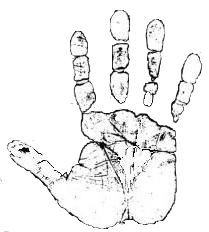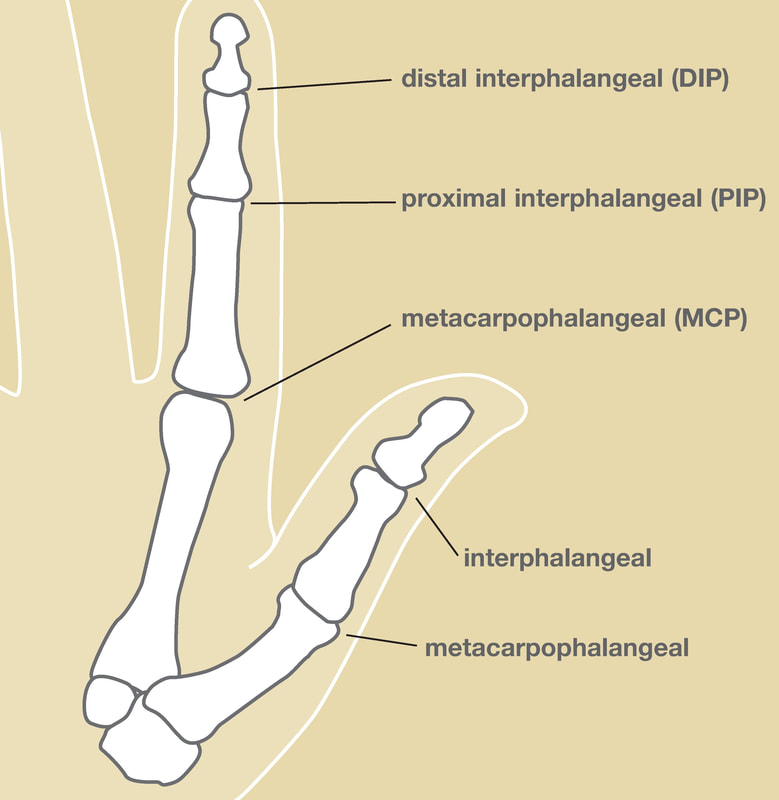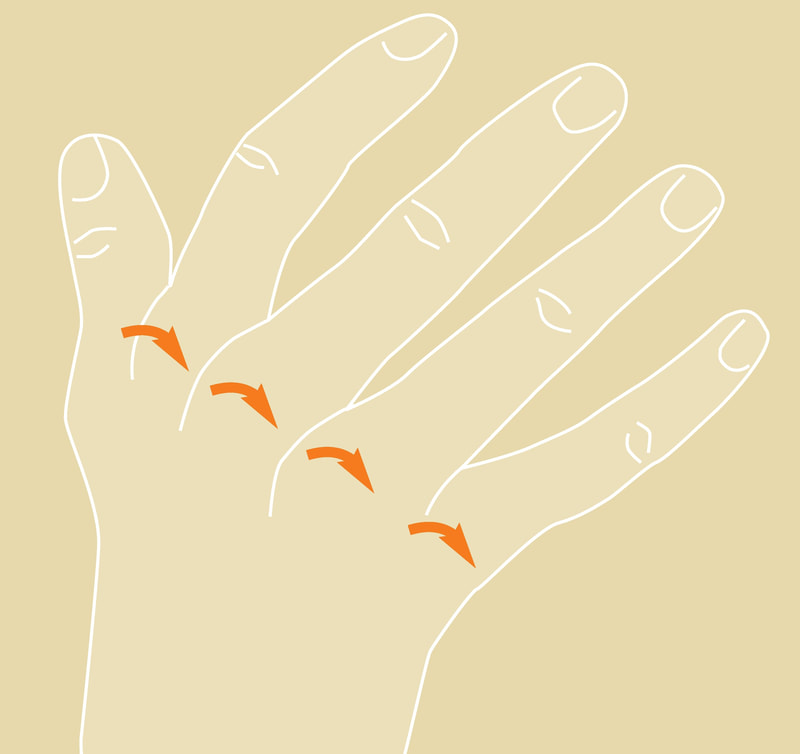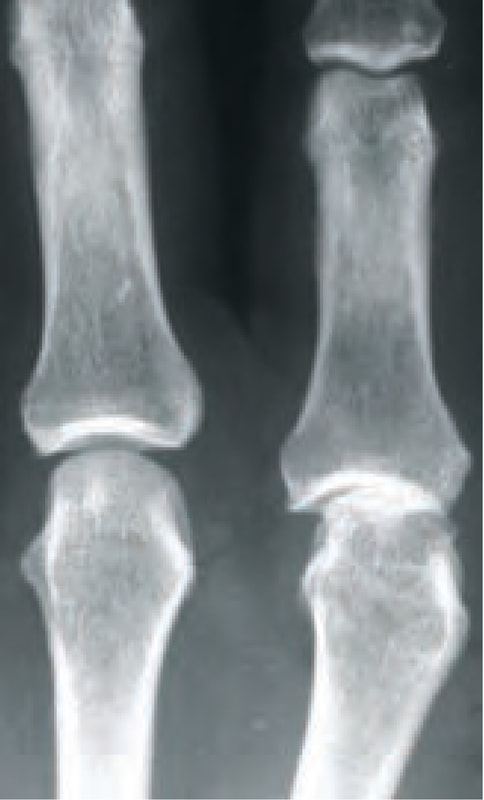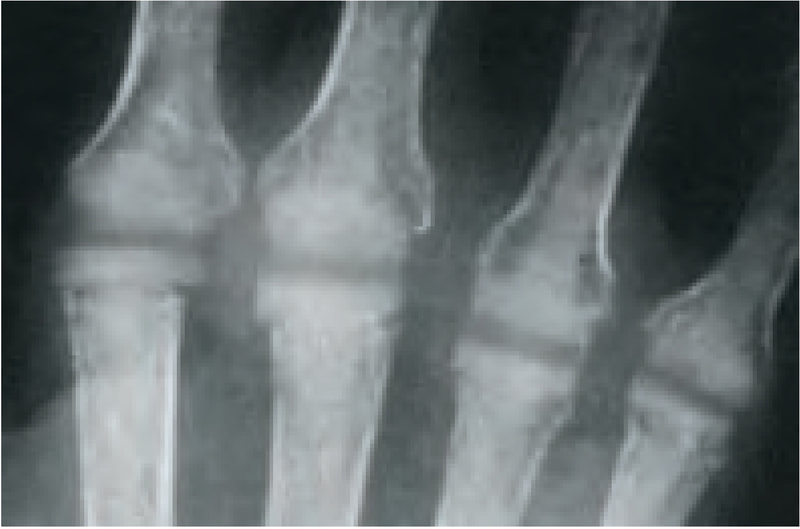MAKE AN APPOINTMENT TODAY!
Knuckle Arthritis
The large hand joints at the base of each finger form knuckles and are known as the metacarpophalangeal joints (MP joints or MCP joints, see Figure 1). They act as hinge joints and allow hands to power grip and fingers to pinch. Knuckle arthritis is less common than other forms of arthritis, which predominately affect the phalangeal bones and the interphalangeal joints (PIP or middle joint and distal or DIP joint) or the basilar joint where the thumb joins the wrist.
The most common arthritis affecting the knuckle joints is rheumatoid arthritis, an autoimmune disease that belongs to the rheumatic disease family. In rheumatoid arthritis, the joint lining secretes chemical factors into the joint fluid or synovial fluid, which causes chronic joint inflammation and joint damage through the destruction of cartilage, ligaments, and tendons. Common chemical factors secreted by the synovial lining are the rheumatoid factor, anti-cyclic citrullinated peptide, and antinuclear antibody.
In addition to stiff joints, joint pain, and swollen joints, the common knuckle arthritis symptoms include knuckle joint deformities where finger bones point toward the small finger. This characteristic ulnar deviation is commonly referred to as the ulnar drift (see Figure 2).
Other less common types of arthritis resulting in knuckle arthritis include degenerative arthritis such as osteoarthritis and post-traumatic arthritis, which result in a gradual loss of joint cartilage with progressive pain, joint stiffness, finger deformity, and decreased range of motion. Other kinds of knuckle arthritis include psoriatic arthritis, gout arthritis, and infectious or reactive arthritis.
The most common arthritis affecting the knuckle joints is rheumatoid arthritis, an autoimmune disease that belongs to the rheumatic disease family. In rheumatoid arthritis, the joint lining secretes chemical factors into the joint fluid or synovial fluid, which causes chronic joint inflammation and joint damage through the destruction of cartilage, ligaments, and tendons. Common chemical factors secreted by the synovial lining are the rheumatoid factor, anti-cyclic citrullinated peptide, and antinuclear antibody.
In addition to stiff joints, joint pain, and swollen joints, the common knuckle arthritis symptoms include knuckle joint deformities where finger bones point toward the small finger. This characteristic ulnar deviation is commonly referred to as the ulnar drift (see Figure 2).
Other less common types of arthritis resulting in knuckle arthritis include degenerative arthritis such as osteoarthritis and post-traumatic arthritis, which result in a gradual loss of joint cartilage with progressive pain, joint stiffness, finger deformity, and decreased range of motion. Other kinds of knuckle arthritis include psoriatic arthritis, gout arthritis, and infectious or reactive arthritis.
Knuckle Arthritis Treatment Options
Various options for knuckle arthritis treatment are available based upon the type of arthritis, signs of disease severity, degree of joint destruction, loss of function, and the overall impact on the patient's quality of life.
Currently, there is no rheumatoid arthritis cure; however, antirheumatic drugs can slow the progression of rheumatoid arthritis. These medications can minimize the overall symptoms of rheumatoid arthritis, including joint swelling and joint inflammation, and reduce the symptoms of knuckle pain. Other non-surgical treatment options include over-the-counter medications such as nonsteroidal anti-inflammatory drugs, which may provide pain relief for the early symptoms of knuckle arthritis (dull ache, morning stiffness, and joint pain) and improve joint function and activity level.
If antirheumatic or anti-inflammatory medications fail to reduce symptoms of knuckle pain or slow the progression of rheumatoid arthritis, cortisone injections into the arthritic joints can offer temporary pain relief. In cases of post-traumatic knuckle arthritis, over-the-counter pain reliever, physical activity modification, and splinting can be beneficial.
For some patients with arthritis, surgical options may offer a sense of relief. Some patients may benefit from synovectomy, in which the inflamed synovial lining is removed to slow the destruction of joint cartilage. Tightening and re-alignment of ligaments and tendons can improve hand function and range of motion.
In people with rheumatoid arthritis where the severity of arthritis markedly impacts their everyday tasks, joint fusion or joint replacement with joint implants (Figure 4) may help severe symptoms of arthritis.
Currently, there is no rheumatoid arthritis cure; however, antirheumatic drugs can slow the progression of rheumatoid arthritis. These medications can minimize the overall symptoms of rheumatoid arthritis, including joint swelling and joint inflammation, and reduce the symptoms of knuckle pain. Other non-surgical treatment options include over-the-counter medications such as nonsteroidal anti-inflammatory drugs, which may provide pain relief for the early symptoms of knuckle arthritis (dull ache, morning stiffness, and joint pain) and improve joint function and activity level.
If antirheumatic or anti-inflammatory medications fail to reduce symptoms of knuckle pain or slow the progression of rheumatoid arthritis, cortisone injections into the arthritic joints can offer temporary pain relief. In cases of post-traumatic knuckle arthritis, over-the-counter pain reliever, physical activity modification, and splinting can be beneficial.
For some patients with arthritis, surgical options may offer a sense of relief. Some patients may benefit from synovectomy, in which the inflamed synovial lining is removed to slow the destruction of joint cartilage. Tightening and re-alignment of ligaments and tendons can improve hand function and range of motion.
In people with rheumatoid arthritis where the severity of arthritis markedly impacts their everyday tasks, joint fusion or joint replacement with joint implants (Figure 4) may help severe symptoms of arthritis.
Reproduced with permission from the American Society for Surgery of the Hand www.handcare.org
Disclaimer and Privacy
IZADIHAND.COM © 2011-2022 Kayvon David Izadi MD - All Rights Reserved
Webmaster
IZADIHAND.COM © 2011-2022 Kayvon David Izadi MD - All Rights Reserved
Webmaster
